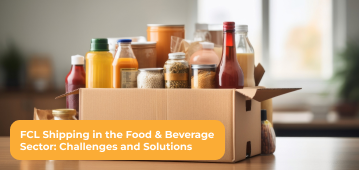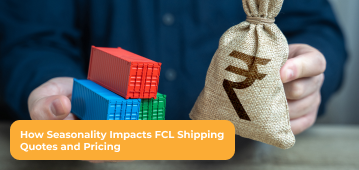All About Full Container Load (FCL) Shipping
Deciding the shipping method is the crucial part of expanding a business internationally. Businesses can choose between air freight, ocean freight, or road freight. However, regardless of the options chosen, there is one choice that almost always confuses business owners. Should they choose full container load (FCL) Shipping or less than container load (LCL) shipping for their shipment?
This article discusses the primary differences between FCL and LCL. Furthermore, we have also provided a detailed summation of when businesses should choose FCL and what advantages they can expect out of FCL shipment.
FCL vs. LCL
Full container load and less than container load are two shipping terms commonly used for sea or ocean freight. Large cargo consignments or containers are usually used to pack and transport material. Each customer is allotted one container.
The FCL shipping option allows the customer to pack their entire cargo in the same container without compromising on space. If there is space left, the space is not allotted to another customer. Only one customer’s cargo uses the entire container. In contrast, the extra space is allocated to smaller cargo shipments or other customers’ cargo in the LCL option. Therefore, the basic difference is: in FCL, the container is exclusively provided to the customer, while in LCL, the space is shared between two or more customers.
Product type: The FCL option is chosen by businesses that need to transport heavy, large, or delicate cargo. In contrast, LCL is ideal for light and portable cargo.
Shipment pace: The transit time for FCL is low since the entire container is unloaded and directly transported to the customer. In contrast, LCL first requires permissions for various customers’ cargo, and then the cargo is sorted before transport.
Security: There is no significant difference in safety between the two. However, with the LCL option, the chances of cargo being misplaced or mistransported are higher since the cargo needs to be sorted before transport.
When is FCL the best choice?
Given the above comparison, FCL and LCL are two choices that do not seem to have significant differences. However, the choice should be made based on various factors. Three of the most important factors to consider are discussed below:
Size and volume: FCL is ideal for at least 15 cubic metres in size or larger cargo. Since ocean freight has large containers, larger cargo size is ideal than small, lightweight cargo. Three container options are provided: size 20 (approximate capacity 33 cubic metres), size 40 (64.5 cubic metres), and size 40 (76 cubic metres). If the size of the product or volume is small, FCL shipping can be very expensive for the business.
Type of business: FCL shipping is ideal for raw materials or finished goods that are heavy, bulky, and large. For example, transportation of dangerous goods that can pose a risk to the health and safety of the environment or population or manufacturing products can be transported using FCL shipping.
Product quantity: As the sizes mentioned above indicate, businesses need many products using the FCL option. However, if the shipment is of lightweight products such as jewellery, the space is unlikely to be filled. Therefore, the business will suffer a loss if they choose the FCL option.
These are the three factors that might help a business decide if they should choose FCL shipping or not. However, there are various advantages of FCL shipping.
Advantages of FCL shipping
Lightning speed: FCL shipping is a lot faster and more seamless than LCL. Since the container contains cargo from only one business, cargo transportation from the port to the drop-off location is smooth and efficient.
Reliability: FCL shipping also ensures that the chances of the cargo being stolen or damaged are low. Since the container is not opened mid-transit when the ship docks on other ports, the consignment is safe throughout the transit.
Soundness: FCL also ensures the chances of the cargo being lost are low. The container with the business consignment is not opened until the final port is reached. As a result, the only way the cargo can be lost is if the entire container goes missing – which is very unlikely to happen. As a result, FCL promises the highest safety.
Charges: FCL can be cheaper than the LCL option when transporting large goods. The rate is often calculated based on the volume of the product. As a result, even if the container is not filled to the maximum extent, the rates can be in the business’s favour.
FCL is easily one of the best options for businesses that want to transport their cargo with the highest security, efficiency, and speed. FCL is the recommended shipping option for heavy, bulky, large, and manufactured products.
Like





Comments